From 13,000 Asian art objects, five celebratory facts

Today, we’re proud to announce a new phase in our partnership with Google Arts & Culture. In celebration of Asian Pacific American Heritage Month, we’re launching 13,000 new objects from our collection on the platform, allowing new ways of experiencing masterpieces like Miao (Hmong) Women in Bright Moon - II, Shimmering of Heated Air (Kagero), and Star-shaped tile with phoenix design.
As part of this newly-available collection, we’re spotlighting Chinese American artist Bernice Bing with a new story honoring her work in the Bay Area, as well as a 3D immersive exhibition of her artwork in a Web Pocket Gallery. These can all be found in the newest chapter of Asian American art as part of the Asian Pacific American Cultures hub together with content from partners like the Smithsonian Asian Pacific American Center, Asia Society, and the Center for Asian American Media.
To get you started exploring the collection, here are five important Asian American artists you should know from the museum’s collection:
1. Bernice Bing: a queer, Chinese American artist who is just getting her due
San Francisco native Bernice Bing (Lee Yu Bing, 李玉冰, 1936–1998) was an artist and activist whose work was rarely shown in her lifetime. A student of Richard Diebenkorn and Saburo Hasegawa, "Bingo" became a central figure in the Beat scene and later, a dedicated community organizer. In 2022, the Asian Art Museum acquired 20 works by Bing and staged the first retrospective of her work.
Bernice Bing in her North Beach Studio by Charles Snyder, from the Asian Art Museum collection on Google Arts & Culture

2. Carlos Villa: a trailblazing Filipino American visual artist, curator and educator
Born in San Francisco, Carlos Villa (1936–2013) was a groundbreaking American artist whose work broadened the horizons of 20th-century modernism. His search for personal and aesthetic meaning in his own Filipino heritage and global Indigenous cultures led him to develop an original and expansive approach to art and the role of the artist.
Ritual and Tat2 by Carlos Villa, from the Asian Art Museum collection on Google Arts & Culture

3. Jade Snow Wong: esteemed artist and author, and one of the first writers on the 20th-century Chinese American experience
Jade Snow Wong (1922–2006) was an artist and author known for her brightly colored forms inspired by the simple shapes and rich color palette of Chinese ceramics of the Song dynasty. She is also best known as the author of “Fifth Chinese Daughter,” a book that chronicles her life growing up in San Francisco’s Chinatown community. Wong's strong sense of identity withstood the expectations and judgments she faced as an Asian woman. The acclaim she received for her art and writing led the U.S. State Department to ask her to serve as a cultural ambassador speaking to audiences throughout Asia.
Shallow bowl by Jade Snow Wong, from the Asian Art Museum collection on Google Arts & Culture

4. Chiura Obata: renowned landscape artist, professor, and devoted environmentalist
Born in 1885 in Japan, Obata (1885–1975) is renowned as a 20th-century master who merged Japanese painting techniques and styles with modern American abstraction. He studied ink painting before immigrating to California in 1903, settling in San Francisco’s Japantown. After an influential trip to Yosemite, Obata began devoting his art to portraying the beauty of nature. Over the course of a seven-decade career, Obata became a prominent educator at UC Berkeley and a central leader in the California Art scene.
People resting in the Presidio by Chiura Obata, from the Asian Art Museum collection on Google Arts & Culture

5. Jenifer K Wofford: San Francisco–based Filipina American artist and educator
Jenifer K Wofford is a contemporary artist and educator based in the Bay Area. In her site-specific installation Pattern Recognition at the Asian Art Museum, Wofford chose to feature names of other Bay Area-based Asian American artists, including: Kay Sekimachi, Carlos Villa, Ernie Kim, Arthur Okamura, Chiura Obata, Leo Valledor, Ruth Asawa, Bernice Bing, and Jade Snow Wong. Inspired by traditional Asian decorative motifs and the bold, colorful graphics of the 1980s, Wofford’s mural celebrates Asian American artists and immigrant communities.

More from this collection
Miao (Hmong) Women in Bright Moon - II by Wang Jianshan, from the Asian Art Museum collection on Google Arts & Culture
Star-shaped tile with phoenix design from the Asian Art Museum collection on Google Arts & Culture
Shimmering of Heated Air (Kagero) by Shono Shounsai, from the Asian Art Museum collection on Google Arts & Culture
Visit the Asian Pacific American Cultures hub to see more.






